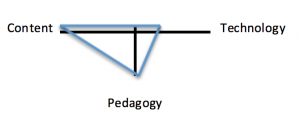Indeed, visualizers are immediate and efficient tools to consolidate understanding. However, visualizers should not simply be regarded as tools for constructing rudimentary conceptual relationships. Rather, information visualizers should also be used to observe alternative thinking models.
More than meets the eye
Scholars strived to find hypothesis to explain why there were no differences between different sized groupings that used information visualizers (Stephens & Clement, 2015). Much of the recent scholarly discussion moved away from investigating how visualizers to construct understanding to optimizing the use of visualizers. More specifically, scholars are investigating about the ways in which specific features of these digital tools benefit users. These “objects to think with” have distinct features that enable users to correct misconception and provide possible alternative thinking models. Features like instant feedback, hassle free play and holistic perspectives make information visualizers appropriate tools that can support users’ search for new thinking models.
Instant Feed Back
One of the most salient features of information visualizers is the interactivity of the digital components. Most visualizers have customized variables that provide instant feedback without requiring users to click additional buttons. Instead of the rigid change and consequence relationship, the seamless manipulation shows progressive changes that are almost undetected in real-time. Quite possibly, this real-time feature helps users develop a deeper understanding of the relationship between variables. More importantly, by observing the gradual change, users can make new and alternative assumptions. This feature exposes the users to more data and results. This feature is found in all three examples of information visualizers (i.e. Netlog, Geometer and Phet).
Hassle free explorative play & learning scaffolds
Undoubtedly, real-time tracking variables are most definitely a prized feature, however, hassle free explorative play and appropriate scaffolds also allows students to take advantage of visualizers. Physical laboratory experiences are often coupled with lessons to consolidate learning. During labs with physical objects, rather than spending time to support content learning, teaching assistants use their time to assuage administrative needs such as physically preparing materials (Srinivasan, Perez, Palmer, Brooks, Wilson & Fowler, 2006). Given the hassle free set up, it releases students to engage in explorative play. This is significant because “[t]his play can lead to the organization of students’ knowledge and its alignment with scientific models.” (Finkelstein, Perkins, Adams, Kohl, & Podolefsky, 2005, p.5) In the grouping study mentioned previously, scholars found that teaching strategies also allow students to attain positive learning gains (Stephens & Clement, 2015). Likewise, it is important for educators to scaffold learning with visualizers. Currently, some tools has explorative suggestions, hints and redirections messages that help students explore alternatives. In NetLogo, there are many variables to manipulative. However, it may be more helpful if the extensions are clearer. Moreover, even though there are teaching guidelines, pHet lessons may require more specific directions to extend learner’s thinking process.
Complex System & Holistic Perspective
While visualizers are often praised for their ability to show micro steps and slow down the process, it also provides a holistic look. Often, the whole system is visible in information visualizers. This fully supports Jacobsen & Wilinsky’s (2006) idea that sometimes learners have to understand concepts that are embedded within a larger complex system. This top-down perspective also alludes to other variables that may influences. Hence, if the current model fails to explain results, students can easily observe other variables to develop alternatives. In pHet lessons, users are usually able to see the whole system that learners are manipulating.
Implications
Although it may be rather early to make the assumption that visualizers should be use solely for deepening understanding. Yet, it may be time for educators to modify their paradigms about the usage of visualizers for surface level learning. Here are some suggestions:
- Educators should consider using information visualizers that have explorative suggestions.
- Educators should couple specific learning scaffolds to help students extend their thinking.
- Researchers should continue to investigate variables that influence the usage of visualizers to modify thinking models.
- Digital tool designers should consider adding more explicit directions to explore alternative thinking models.
Reference
Jacobsen, M. & Wilinsky, U. (2006). Complex systems in education. Scientific and educational importance and implications for the learning sciences. Journal of the Learning Sciences, 15(1), 11-34. http://ezproxy.library.ubc.ca/login?url=http://dx.doi.org/10.1207/s15327809jls1501_4
Srinivasan, S., Perez, L. C., Palmer,R., Brooks,D., Wilson,K., & Fowler. D. (2006). Reality versus simulation. Journal of Science Education and Technology, 15 (2), 137-141. http://ezproxy.library.ubc.ca/login?url=http://dx.doi.org/10.1007/s10956-006-9007-5
Stephens, A. & Clement, J. (2015). Use of physics simulations in whole class and small group settings: Comparative case studies. Computers & Education, 86, 137-156. Available in Course Readings.
Stieff, M., & Wilensky, U. (2003). Connected chemistry – Incorporating interactive simulations into the chemistry classroom. Journal of Science Education and Technology, 12(3), 285-302. http://ezproxy.library.ubc.ca/login?url=http://dx.doi.org/10.1207/s15327809jls1501_4
